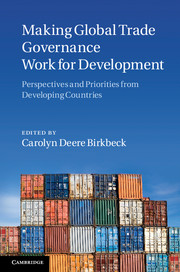 Making Global Trade Governance Work for Development
Making Global Trade Governance Work for Development Book contents
- Frontmatter
- Contents
- Figures
- Tables and boxes
- Contributors
- Acknowledgements
- Introduction
- Part I Global trade governance
- Part II Roles and responsibilities in global trade governance: diversity in developing country priorities and strategies
- 5 New powers in the club: the challenges of global trade governance
- 6 China’s ascent in global trade governance
- 7 LDC priorities for improved global trade governance
- 8 Priorities for small States in global trade governance
- 9 Improving the participation of small developing countries in the governance of the multilateral trading system
- Part III Strengthening multilateralism
- Part IV Making WTO negotiations and decision-making processes fairer
- Part V Conclusion
- Index
- References
6 - China’s ascent in global trade governance
from rule taker to rule shaker and maybe rule maker?
from Part II - Roles and responsibilities in global trade governance: diversity in developing country priorities and strategies
Published online by Cambridge University Press: 07 September 2011
- Frontmatter
- Contents
- Figures
- Tables and boxes
- Contributors
- Acknowledgements
- Introduction
- Part I Global trade governance
- Part II Roles and responsibilities in global trade governance: diversity in developing country priorities and strategies
- 5 New powers in the club: the challenges of global trade governance
- 6 China’s ascent in global trade governance
- 7 LDC priorities for improved global trade governance
- 8 Priorities for small States in global trade governance
- 9 Improving the participation of small developing countries in the governance of the multilateral trading system
- Part III Strengthening multilateralism
- Part IV Making WTO negotiations and decision-making processes fairer
- Part V Conclusion
- Index
- References
Summary
Since China’s accession to the World Trade Organization (WTO) in late 2001, one of the most intriguing questions for trade analysts has been how the ‘new kid on the block’ would behave once it became a formal Member of the multilateral trading system. The question is twofold. First, will China faithfully implement its WTO accession commitments? Second, will China seek to upset the existing power structure in the WTO?
Of the two issues, the first has received the most attention. In addition to abundant media coverage, official statements and academic commentaries, the concern is well illustrated by the following passages from the Working Party Report of China's WTO Accession (WTO 2001a: para.9):
Some members of the Working Party indicated that because of the significant size, rapid growth and transitional nature of the Chinese economy, a pragmatic approach should be taken in determining China's need for recourse to transitional periods and other special provisions in the WTO Agreement available to developing country WTO Members. Each agreement and China's situation should be carefully considered and specifically addressed. […]
- Type
- Chapter
- Information
- Making Global Trade Governance Work for DevelopmentPerspectives and Priorities from Developing Countries, pp. 153 - 180Publisher: Cambridge University PressPrint publication year: 2011
References
- 9
- Cited by
